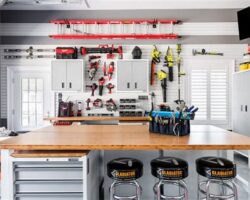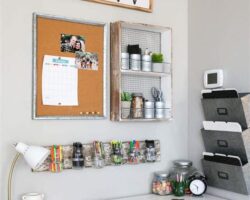Are you tired of working in a disorganized and uninspiring home office? Do you want to take your workspace to the next level and increase your productivity and comfort? If so, you’ve come to the right place. In this blog post, we will guide you through the process of transforming your home office into a well-organized, functional, and motivating work environment. From evaluating your space and needs to establishing clear boundaries and distractions control, we’ll cover it all. You’ll learn about the importance of creating an efficient layout, investing in the right furniture and equipment, enhancing lighting and ergonomics, and optimizing storage and workspace efficiency. By the end of this step-by-step guide, you’ll have the tools and knowledge to design an inspiring and productive atmosphere that will help you excel in your work. So, let’s get started and turn your home office into the workspace of your dreams.
Evaluate Your Space and Needs
When creating an organized and functional workspace, it’s important to evaluate your space and needs carefully. Consider the size and layout of your space, as well as the specific requirements of your work. Take measurements and make note of any limitations or obstacles that may affect the design of your workspace.
Once you have a clear understanding of your space and needs, you can begin to brainstorm potential layouts and configurations. This will help you to visualize the best use of your space and create a plan for how to optimize it for your specific needs.
Be sure to also take into account any specialized equipment or furniture that may be necessary for your work. This will help to ensure that your workspace is not only functional, but also equipped with the right tools and resources to support your productivity.
By taking the time to thoroughly evaluate your space and needs, you can lay a solid foundation for creating a workspace that is both efficient and conducive to your work requirements.
Create an Organized and Functional Layout
Creating an organized and functional layout for your workspace is essential for maximizing productivity and efficiency. By evaluating your space and needs, you can determine the best way to arrange your furniture and equipment to promote a smooth workflow. Consider the size and shape of your space, as well as the specific requirements of your work tasks.
Investing in the right furniture and equipment is key to creating a layout that supports your needs. Choose ergonomic and adjustable pieces that can be customized to fit your space and provide optimal comfort and functionality. This may include adjustable desks, ergonomic chairs, and storage solutions that help to keep your workspace organized and clutter-free.
Enhancing lighting and ergonomics within your workspace is another important aspect of creating an organized and functional layout. Proper lighting and ergonomic furniture can help prevent fatigue, eyestrain, and other common workplace issues, allowing you to focus on your tasks with ease. Consider investing in task lighting, adjustable monitor arms, and other ergonomic accessories to enhance your workspace.
Lastly, establishing clear boundaries and distractions control within your workspace can help you stay focused and productive. This may involve setting specific work hours, creating physical or visual barriers to minimize distractions, and implementing digital tools or apps to help you stay on track. By creating a dedicated and organized layout for your workspace, you can optimize your efficiency and create a productive environment that supports your work goals.
Invest in the Right Furniture and Equipment
Invest in the Right Furniture and Equipment
Choosing the right furniture and equipment for your workspace is crucial in creating a productive and comfortable environment. Whether you work from home or in an office, having the appropriate furniture and equipment can greatly impact your efficiency and well-being.
Investing in a quality desk and chair is essential to maintain a good posture and prevent any physical discomfort or injury. An ergonomic chair that provides proper support for your back and a desk at the right height can contribute to a healthier work routine.
Additionally, consider the storage solutions that best fit your needs. Whether it’s cabinets, shelves, or drawers, having ample storage to keep your workspace organized can help improve your overall productivity and reduce clutter.
Lastly, don’t overlook the technological aspect when it comes to equipment. From computers and printers to lighting and other office essentials, investing in the right tools can streamline your work processes and enhance your overall experience in the workspace.
Enhance Lighting and Ergonomics
Enhancing lighting and ergonomics in your workspace can have a significant impact on your productivity and overall well-being.
Investing in LED task lighting can help reduce eye strain and create a more comfortable work environment. Positioning the light source to minimize glare and shadows can also improve visibility and reduce the risk of headaches or eye discomfort.
When it comes to ergonomics, choosing an adjustable desk chair and ensuring your computer monitor is at eye level can help prevent neck and back pain. Incorporating a standing desk into your workspace can also promote movement and reduce the negative effects of prolonged sitting.
By prioritizing proper lighting and ergonomic furniture, you can create a more comfortable and productive work environment for yourself.
Design an Inspiring and Productive Atmosphere
When designing an inspiring and productive atmosphere for your workspace, it’s important to consider the overall aesthetic and functionality of the space. By incorporating elements that motivate and energize you, you can create a space that encourages creativity and focus.
Start by choosing colors and decor that promote a positive and inspiring environment. Bright, vibrant colors can help stimulate creativity and alertness, while calming blues and greens can promote a sense of tranquility and focus. Consider incorporating artwork or motivational quotes that resonate with you and inspire you to do your best work.
It’s also important to think about the layout and flow of the space. Arrange your furniture and equipment in a way that minimizes clutter and maximizes efficiency. A clean, organized workspace can help clear your mind and improve productivity.
Finally, don’t underestimate the impact of lighting and ergonomics on your workspace. Natural light can boost mood and productivity, so try to position your workspace near a window if possible. Invest in ergonomic furniture and lighting solutions that reduce strain and fatigue, keeping you comfortable and focused throughout the day.
Optimize Storage and Workspace Efficiency
When it comes to creating an efficient and productive workspace, one of the key factors to consider is optimizing storage and workspace efficiency. This can make a significant difference in how well your space functions and how organized you are able to keep it.
Investing in smart storage solutions such as shelving, cabinets, and desk organizers can help you make the most of your available space. By utilizing vertical storage and making use of underutilized areas, you can free up valuable workspace and keep essential items within reach.
Additionally, considering the workflow in your space and designing your storage solutions around it can further enhance efficiency. Placing frequently used items within easy reach and ensuring that there is a designated place for everything can minimize clutter and streamline your work process.
Moreover, incorporating multi-functional furniture and workspace solutions can help maximize efficiency. Desks with built-in storage, modular furniture, and flexible workstations can help you adapt to different tasks and keep your workspace organized.
Establish Clear Boundaries and Distractions Control
When working from home, it is crucial to establish clear boundaries between your work and personal life. This can be achieved by setting specific work hours and sticking to them. Creating a dedicated workspace away from common living areas can also help to create a mental separation between work and relaxation.
Distraction control is equally important in a home office setting. This can involve minimizing interruptions from family members or roommates, as well as implementing digital boundaries such as turning off notifications during work hours. Setting clear guidelines and expectations with those sharing your space can help to create a productive work environment.
Establishing clear boundaries and distractions control can significantly improve focus and productivity, making it easier to achieve a healthy work-life balance when working from home.
By prioritizing these aspects of your home office setup, you can create a more conducive environment for getting work done efficiently and effectively while still maintaining a sense of separation between work and personal life.





